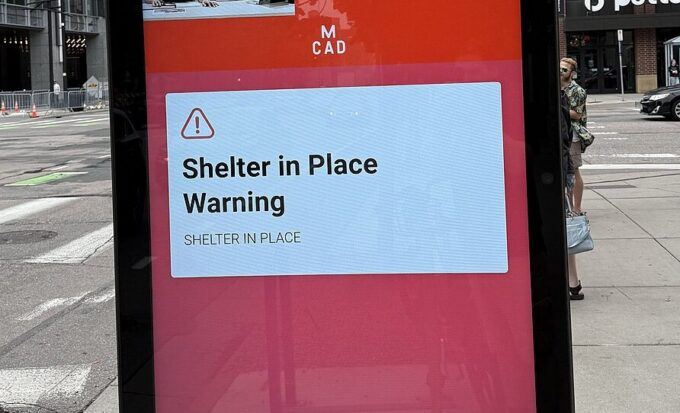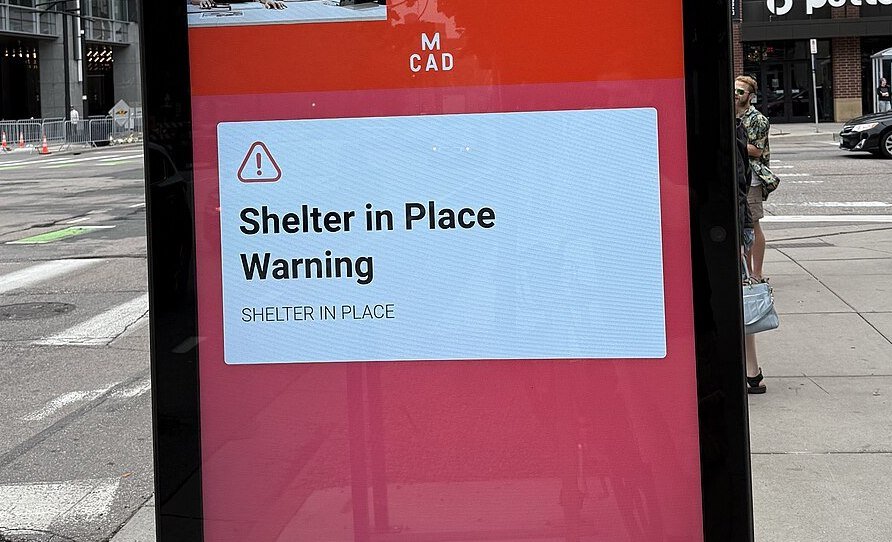
A shelter-in-place warning in downtown Minneapolis. Photograph Source: SavagePanda845 (Elliot F) – CC BY 4.0
The cold truth is this: political violence works. The assassination and attempted assassination of two Minnesota state legislators remind us again that violence is not just a tragedy—it is a tactic. In democratic societies, people are taught to condemn such actions and to see them as aberrations. Yet the historical record tells us something far more uncomfortable: political violence is effective, and that is why it continues.
People cling to the idea that political violence is not only immoral but counterproductive. If it were truly ineffective, rational actors would abandon it. But they have not. Too often, political violence delivers results—through intimidation, disruption, or the outright removal of opposition.
Consider the 20th and 21st centuries: the Armenian Genocide, the Holocaust, the Khmer Rouge’s massacres in Cambodia, Rwanda’s 1994 genocide, the ethnic cleansing in Bosnia, the ongoing repression of Uyghurs in China, and the violent persecution of the Rohingya in Myanmar. Each was a brutal campaign to eliminate a people, and though they did not achieve total eradication, they succeeded in redrawing borders, consolidating power, and annihilating political threats. Some argue that Israeli actions in Gaza amount to genocidal violence. These acts were not random; they were strategic, calculated, and tragically successful.
The September 11 attacks rewired global security and surveillance infrastructure overnight. The 1917 Russian Revolution dismantled a monarchy and birthed a global communist empire. The Spanish Civil War set the stage for fascist dictatorship and served as a rehearsal for World War II. The violence surrounding the 1947 Partition of India and Pakistan created two nations and left behind scars that shape South Asia to this day.
Pinochet’s 1973 military coup in Chile crushed socialism and ushered in decades of neoliberal authoritarianism. North Korea remains one of the most repressive regimes on Earth, its power preserved through political terror. The Taliban’s violent resurgence in Afghanistan after twenty years of war is further proof that force can undo democratic aspirations. Violence does not just challenge democratic systems—it often replaces them.
In the United States, political violence has shaped the arc of history. Lincoln’s assassination ended Reconstruction before it truly began. The killings of John F. Kennedy, Robert Kennedy, Martin Luther King Jr., and Malcolm X decapitated movements for civil rights, justice, and reform. The 1995 Oklahoma City bombing, the deadliest act of domestic terrorism before 9/11, was aimed squarely at undermining trust in the federal government.
The 2020 plot to kidnap Michigan Governor Gretchen Whitmer was not a fringe fantasy—it was an attempted insurrection. The January 6 assault on the U.S. Capitol did not just rattle windows; it shattered illusions. It proved that political violence is not a relic of the past. It is here, now, and dangerously normalized.
From the lynchings and burnings by the Ku Klux Klan to the systemic destruction of Black Wall Street in Tulsa in 1921, white supremacist violence operated with impunity. These acts were not random—they were designed to crush Black political and economic advancement. Native Americans were massacred, displaced, and stripped of sovereignty. The Wounded Knee Massacre, Indian Removal, and the reservation system were all forms of state-sponsored political violence.
These campaigns depopulated, demoralized, and disenfranchised entire peoples—and they worked. Political violence was used to maintain power, suppress democracy, and preserve racial hierarchies. Whether through mob rule or official policy, it has long been a tool of dominance in American political life. The results are still visible in the disparities and structural inequalities of today.
Some argue that violence only provides fleeting success. But in politics, a year can reshape a lifetime. A decade can redirect a nation. Even a single act—an assassination, a bombing, a riot—can reconfigure the structures of power so deeply that nothing returns to its previous state.
In democracies, political violence is supposed to be unnecessary. People are taught to believe in elections, deliberation, and law. But when violence succeeds—when it silences opposition or disrupts government—it sends a chilling message: the rule of law is optional. For those willing to kill, threaten, or destroy, the system can be manipulated or broken.
The international order claims to be rule-based, founded on diplomacy and legal norms. But the evidence suggests otherwise. Russia’s 2014 annexation of Crimea, its 2022 full-scale invasion of Ukraine, China’s militarization of the South China Sea, and the United States-led war in Iraq all demonstrate that violence remains a tool of statecraft. These actions, regardless of justification, reshaped borders and geopolitics through brute force.
Political violence is still a currency of global power. It is not merely the weapon of the weak, but also the preferred instrument of regimes and elites seeking control. The world has not outgrown violence as a political strategy. It has simply become more selective and sophisticated in its application.
Make no mistake: this author condemns political violence. It is destructive, anti-democratic, and morally corrosive. Yet pretending it does not work is self-deception. History’s harshest lesson is this—while political violence is almost always wrong, it is also, disturbingly, effective.
The post The Tragedy of Political Violence: It Works appeared first on CounterPunch.org.

